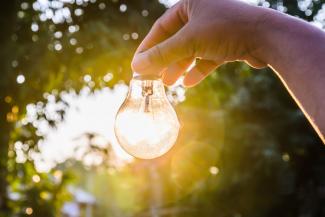
Instructions
Do the preparation task first. Then read the article and do the exercises to check your understanding.
What is Earth Hour?
Earth Hour is organised by the World Wide Fund for Nature (WWF) and it's a big event usually at the end of March every year. On this evening, people 'go dark' – that is, switch off lights in their homes, schools and businesses all at the same time for one hour.
Earth Hour started in Australia in 2007, when 2.2 million people in Sydney turned off all unnecessary lights for an hour. Since then it has grown into an international event, and many countries around the world have taken part. Famous buildings that have gone dark for Earth Hour include the Sydney Opera House and Harbour Bridge, the Petronas Towers in Kuala Lumpur, the Houses of Parliament and Buckingham Palace in London, the Eiffel Tower in Paris, the Forbidden City in Beijing and New York's Empire State Building. Even astronauts on the International Space Station have taken part by reducing their power use on the station, and Google has shown its support by making a dark homepage for the event.
What's the idea behind Earth Hour?
The idea is to raise awareness of environmental issues and call for action to protect nature, so that people enjoy healthy, happy and sustainable lives now and in the future.
It's true that switching off the lights for just one hour saves only a small amount of power. But this is only the beginning. On one level, joining in Earth Hour makes people think about the problem of climate change and what we can do in everyday life to protect nature. For example, eating less meat, using low-energy electrical items instead of high-energy ones and using green forms of transport all help the planet.
But on another level, a large number of people all acting together sends a powerful message to governments and companies. It pushes them to take urgent action on a large scale by making changes to laws and by considering green issues when making big decisions.
What does '60+' mean?
The logo of Earth Hour is '60+'. The number 60 is for the 60 minutes of Earth Hour, and the plus invites people to keep on taking action even after Earth Hour is finished. In fact, people who join in Earth Hour say that taking part makes them want to do more for the environment. The climate activist Greta Thunberg says that 'Earth Hour is every hour of every day.'
What else do people do, apart from switching off the lights?
There are a lot of events that people can join. There are concerts performed with acoustic instruments instead of electric ones, and using candles instead of electric light. Celebrity chefs have created special recipes for families to prepare and eat by candlelight. There are also tree-planting sessions, group walks and runs, and meditation sessions.
Why March?
Around the end of March in the northern and southern hemispheres, the days and nights are the same length, which is called an equinox. It means that at this time of year, the sunset is at a similar time in both hemispheres, so it is dark in the evening in each country for the Earth Hour switch-off.
Do you think Earth Hour is a good idea? Will you take part?

Comments